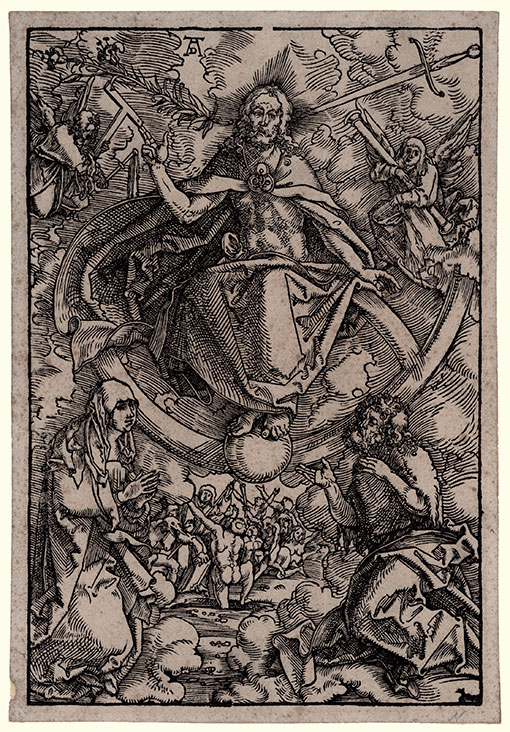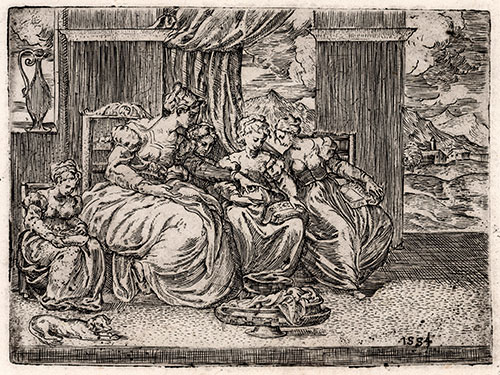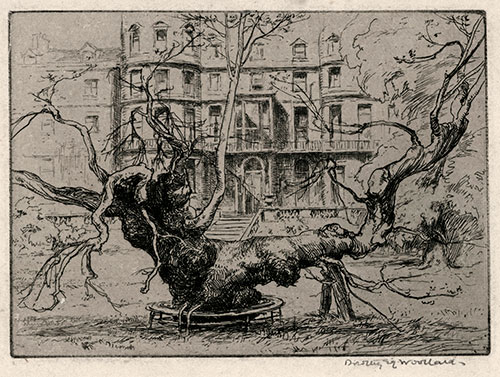The
Home Page Selection
If
you require further information on any
print featured here, please contact
us.
When
a print has been sold it will be marked
as Sold.
A
growing archive of selections
from previous Home pages is featured in
the
Home
Page Selection Archive |
|
See
also :
Click
on a thumbnail (left)
to link directly with the entry for that
print, or scroll down to view all the selected
prints from the current Home
Page.
Images
are not to relative scale (see stated dimensions) and also at only modest resolution.
If you wish to view extracts of an image at higher resolution, please Contact us.
|
|
|
|

| |
HANS BALDUNG (GRIEN)
Schwäbisch-Gmünd 1484/85 – 1545 Strasbourg
Unusually for the time, Baldung was from a family of lawyers, doctors, professors.
He was the only male member of his family not to receive a university education.
Nothing is known of Baldung’s early training but from 1503 to about 1507
he worked as a journeyman with Dürer.
It was probably from Dürer that Baldung acquired his nickname Grien,
perhaps to distinguish him from the other Hans in Dürer’s workshop at the time -
Hans Shäufelein, Hans von Kulmbach, and Dürer’s younger brother, Hans.
It has been postulated that the name came from Baldung’s preference for wearing green,
as he does in an early self-portrait he included in an altarpiece.
Whatever its origin, Baldung incorporated a G into his monogram.
In 1507 he was summoned to Halle to paint an altarpiece and by 1509 he had moved
to Strasbourg, but Dürer and Baldung remained lifelong friends.
After Dürer’s death Baldung was sent a lock of his hair (today in the Albertina).
Though Baldung was influenced by Dürer, he was a highly original artist
and quickly established his own expressive, idiosyncratic style,
and subject matter, occasionally involving witches and horses,
for which he is best known today.
He was also one of the first artists to make chiaroscuro colour-printed woodcuts.
Last Judgement
Illustrated Bartsch 142 (as Dürer), Hollstein 58 ii/ii
263 x 174 mm
Woodcut, c1505-07.
Second state, with the later added false AD monogram of Dürer.
On unwatermarked laid paper, with narrow margins,
backed at the sheet edges making up for one small paper loss
in the bottom left margin.
Sold
A dynamic composition, with the circular swirl of Christ’s cloak
and the curve supporting the sphere his feet rest on,
while he sits in judgement on a rainbow,
offset by the diagonals above on each side created by the lily,
sword and the instruments of the Passion.
Mary and St John intercede below on behalf of humanity.
Return to top ^ |
|
|
|

|
|
Circle of PARMIGIANINO
A needlework lesson
Allgemeines Kunstler Lexicon 57, as Giovanni Battista d’Angolo;
otherwise unrecorded
134 x 179 mm
A rare 16th century anonymous North Italian etching,
long thought to be after a lost drawing by Parmigianino.
Probably second state of two, with the date 1554 added.
On laid paper with part of a crossed arrows with star
watermark (cf Briquet 6291, 6299, 6300)
£2000
An unusual and delightful scene of cultivated domestic activity
taking place in an open loggia with landscape views,
which has attracted a number of etchers.
The British Museum has examples from two different 16th century Italian hands;
one being the author of the present print, in two impressions,
both before the addition of the date 1554 to the plate.
Later, before 1803 when he included it in a catalogue of his work,
the Baron Vivant Denon also etched this image, without the date,
in reverse. Denon added his name to the plate as etcher as well as
that of Parmigianino ‘Parm inv’ (designed by Parmigianino).
A more recent suggestion of authorship has been Angelo Falconetto (1507-1567).
Return to top ^ |
|
|
|
 |
|
FRANCISCO GOYA y Lucentes
Fuente de Todos, Aragon 1746 – 1828 Bordeaux
Los Disparates (Follies or Irrationalities) was Goya’s last series
of etchings and remained unpublished in his lifetime.
It is incidentally interesting that, as with his other late etchings,
they were etched on English copper plates.
They were packed away in Goya’s Spanish home when Goya left
for France in 1824.
Eighteen of the twenty-two extant plates were first issued in 1864
under the title Los Proverbios (Proverbs).
Some of the plates can be seen as relating to Spanish proverbs,
and the word at the period also applied to allegories which needed
an interpretation.
The current title of Los Disparates follows the discovery of working proofs
with titles, in Goya’s own hand, most of which included
the word Disparata (Folly) and a characteristic, such as the
Disparate de Carnabal (Carnival Folly) offered here.
“Many of the prints have been shown to represent carnival themes
and it is quite possible that Goya used Carnival as an allegory
through which to express complex ideas which may include particular
as well as general allusions to the state of Spain and to his personal
and private world which, since the time of the Caprichos, had always
been intermingled in his works of ‘capricho and invention’.”
(Juliet Wilson Barreau)
Plate numbers were added for eight further editions 1875 - 1930.
The plates were etched in Spain probably between 1815 and 1819,
when the artist suffered another serious bout of illness;
a period when the Spanish government was repressive.
Disparate de Carnabal  Carnival folly Carnival folly
Alegrias antruejo, que manana seras cenzia
Rejoice, carnival, for tomorrow thou will be ashes
Harris 261; Delteil 215; pl.14 of Los Disparates
245 x 352 (bevelled plate)
Original etching with aquatint, c1816.
Fifth edition, 1904, well printed in black ink on cream wove paper.
£1500
An alternative proverb might be
Si la locura fuese dolores,
en cada casa darian voces -
If madness were pains,
there would be shouts from every house.
Return
to top ^ |
|
|
|
 |
|
WALTER GREAVES
Cheyne Row, Chelsea 1846 – 1930 Hammersmith Hospital
The son of a Chelsea boat builder and waterman,
Greaves met Whistler when the latter moved to Chelsea in 1863.
With his brother Henry, Greaves rowed Whistler on the Thames
to find motifs.
In the 1870’s he assisted Whistler in decorating the Mall Gallery
for Whistler’s first exhibition, and helped with the Peacock Room.
Greaves etchings mainly date from the 1870’s and early 1880’s
while he was quite closely associated with Whistler, after which
he went into decline, but in 1911 he was given a single solo exhibition
of his work.
Most of the extant impressions of his etchings were probably printed
for this exhibition.
The Adam & Eve
125 x 200 mm
Original etching, c1870’s.
The plate signed.
Also signed in pencil.
On cream laid paper.
£500
The Thames-side public house in Chelsea
was also etched by Whistler, in 1878.
It was demolished when the Chelsea Embankment was built.
Return
to top ^ |
|
|
|
 |
|
WALTER SEYMOUR
St Pancras, London, 1848 – 1920 Godstone, Surrey
A landscape and figure painter but primarily an engraver,
Seymour exhibited prints at the Royal Academy 1905-1914.
During this period he taught at the LCC Bolt Court School
of Engraving and Lithography, where Blampied and van Abbé
were amongst his etching students.
(Harvest - Twilight)
205 x 326 mm
Original mezzotint, 1897.
Signed in pencil.
With the London publication line of M Cohen, 1897.
Printed on Van Gelder Zonen cream laid paper.
Time toned.
Sold
Return
to top ^ |
|
|
|
 |
|
DOROTHY E G WOOLLARD R.E.
Clifton, Bristol 1886 – 1986 Cambridge
Dorothy Woollard began etching as a student of Reginald Bush
at Bristol School of Art in the early 1900’s and exhibited
for the first time in 1910.
In 1913 she moved to London to take up a scholarship to the Royal
College of Art, under Frank Short. Because of the intervention
of the First World War, when she worked for the Admiralty mapmaking,
Woollard did not graduate until 1923, though she had been elected
an Associate of the R.E. in 1916 and became a Fellow in 1925.
She was another etcher who contributed a miniature etching for
Queen Mary’s Dolls house.
Several of her etchings show an interest in trees,
and her Diploma Print for the R.E. was Burnham Beeches.
(Study of an old gnarled tree)
Not recorded in Roger Staton Dorothy Woollard and the etching revival
109 x 151 mm
Original etching, signed in pencil.
On japan.
£175
Return
to top ^ |
|
|
|
|
|
|
|